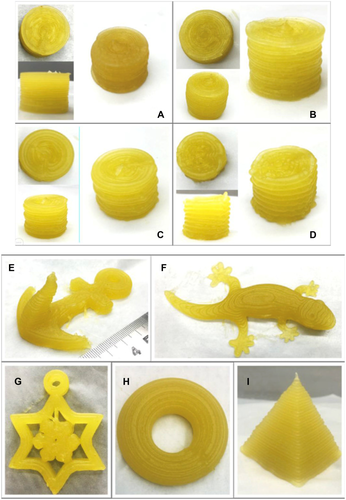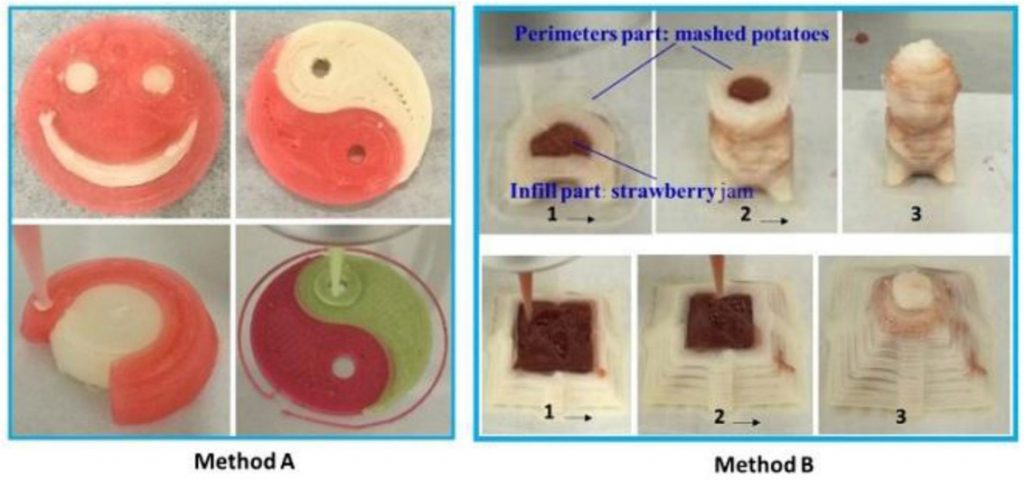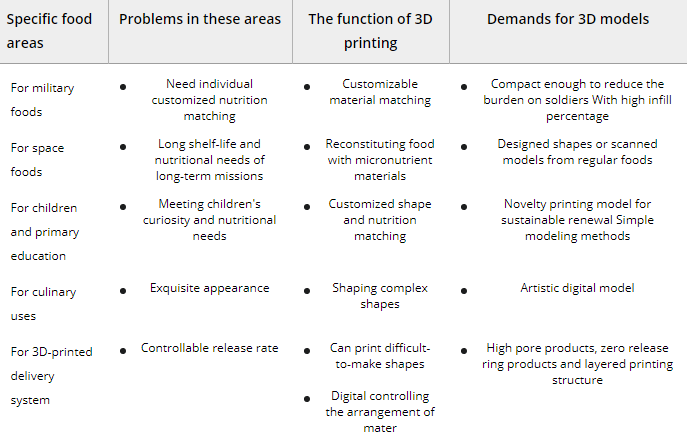The potential for 3D printed food and associated hardware, software, and materials is vast—causing researchers from China and Australia to look further into the merits of the technology and more specific features like slicing methods during the 3D design process. Authors Chaofan Guo, Min Zhang, and Bhesh Bhandari outline their work in the recently published paper, ‘Model Building and Slicing in Food 3D Printing Processes: A Review.’
While much attention has been paid to the methodology of fabricating foods via 3D printers, the intricacies of design and settings are rarely discussed. The authors strive to focus on 3D printer requirements, settings for slicing, and techniques and optimization processes.
As the necessary hardware has become available and improved over time, it has been proven that 3D printed foods can be produced—as well as ‘trimmed, cooked, or baked as required.’ The authors point out, however, that challenges still arise regarding structure and stability, performance of ingredients, post-processing methods, and resulting issues with deformation of prints.
The following printing parameters are crucial:
- Printing height
- Printing rate
- Nozzle diameter
- Nozzle movement rate
- Layer thickness
- Temperature
The whole process starts with a design, and not only should that be one that is functional and stable—it should please consumers and meet their varying needs. The authors point out that while CAD-based model building is extremely useful for those with extensive experience, most users and designers benefit in working with a template or a scanned object. Pre-established models have been very helpful in previous research too, such as the fabrication of lemon juice gel printed objects.
The military has embraced 3D printing for many different uses, and food is one of them as sustenance can be customized, made in smaller and more lightweight form, and stored easily. The designs, however, must be well-structured, and contain a high percentage of infill.
“Moreover, combining with the ultrasonic agglomeration, the particles of 3D printed objects can be fused together by emitting ultrasonic waves,” state the researchers.

Pictures of lemon juice gel printed objects. (A)–(D) are cylinders with different nozzle diameter (A = 0.5 mm, B = 1.0 mm, C = 1.5 mm, D = 2.0 mm). (E)–(I) are products printed at 24 mm3/s extruded rate, 30 mm/s nozzle moving speed and 1.0 mm nozzle diameter (E. Anchor, F. Gecko, C. Snowflake, D. Ring, E. Tetrahedron) (Yang et al. 2018).
NASA has continued to experiment with 3D printing in the food arena as well, but with challenge:
“Current food systems cannot meet the shelf‐life and nutritional needs of long‐term missions,” state the researchers. “The ‘printing’ machine in spacecraft based on additive manufacturing can print various food geometries from food ingredients for astronauts to ‘reconstituted’ foods. These ‘reconstituted’ foods can be made by designed shapes or scanned models from regular foods, which will be helpful to reduce the boredom of long‐term space operations.”
Ongoing research into better 3D printing of food for long-term missions for astronauts has resulted in the development of complex structures, however, with designs created to mimic skeleton and cardiac muscle—printed with protein-rich inks. 3D printing technology has also proven to be helpful in education as kids enjoy making food while mastering different aspects of STEM learning.
And while many of us have the best of intentions when baking a cake or making a gourmet delicacy, we don’t always have the mastery—or talent—to pull off complex endeavors with food. With 3D printing, users (as well as restaurateurs) can create customized, complex shapes but leave the precision to the printer:
“Although, theoretically, 3D food printing technology has come out for some time, until 2016 the world’s first 3D food printing restaurant was set up by Food Inc. at London. In September 2018, Jan Smink, Top Chef and Ambassador of byFlow, opened his new restaurant in Walwiga, bringing 3D print cuisine into our sight. Cuisines made by 3D printing technology can create a special experience for the guests with an artistic appearance made by fully designed models,” state the researchers.

Photos of 3D printed dishes made by Jan Smink. (A) Celery Hazelnut Paste, (B) Berenhap 2.0 with curry paste, and (C) 3D printer cream cheese.
Slicing software is critical for numerous reasons—but mainly in converting .stl files to G-Code. Beginners may be working with slicing software that is pre-set, while more advanced users are able to set all the parameters, and in some cases even assisting in repair.
“Besides the model design, 3D printer and printing materials optimization, slicing software is another crucial factor that can achieve an optimized printing effect. The slicing software is an intermediate driver for route planning and calculating sections between the 3D model and the 3D printer. In other words, slicing software is a tool that can transform the digital model into a hypostatic model,” state the researchers.
Overall, while the researchers note the tremendous amount of innovation and progress developers have made over the years, they recommend that more attention be given to developing models for 3D printing food—especially in model building and slicing software. This should begin with further study of consumers who would enjoy the technology, along with developing specific slicing technology for 3D printing food and making more extensive use of numerical analysis.
While 3D printing offers a wide range of industrial uses that have the potential to change the way we manufacture objects, prototypes, and parts forever, there are many fun aspects to the technology as well—and everyone loves to check out what’s happening on the food front, especially if it is around mealtime! Over the years, engineers and designers have brought us different ways to extrude food, from 3D printed steak or chicken to fancy pancakes and even concepts for airline food or meals to be fabricated in nursing homes for patients with dysphagia (trouble swallowing).
What do you think of this news? Let us know your thoughts! Join the discussion of this and other 3D printing topics at 3DPrintBoard.com.

Samples printed by using the 2‐nozzle 3D printer. Method A: create two pre‐designed separate 3D standard triangle language (stl) models sharing the same coordinates within Rhinoceros program. The two stl files were then merged into a single multi‐material file and assigned each file to one extruder (one material). Method B: create one 3D stl model and divide it into “infill part” and “perimeters part”, and each part was then assigned to one extruder (one material). The photos in Method B were taken at the beginning, middle and finishing stage during printing process from left to right (Liu et al., 2018c).
Subscribe to Our Email Newsletter
Stay up-to-date on all the latest news from the 3D printing industry and receive information and offers from third party vendors.
You May Also Like
Profiling a Construction 3D Printing Pioneer: US Army Corps of Engineers’ Megan Kreiger
The world of construction 3D printing is still so new that the true experts can probably be counted on two hands. Among them is Megan Kreiger, Portfolio Manager of Additive...
US Army Corps of Engineers Taps Lincoln Electric & Eaton for Largest 3D Printed US Civil Works Part
The Soo Locks sit on the US-Canadian border, enabling maritime travel between Lake Superior and Lake Huron, from which ships can reach the rest of the Great Lakes. Crafts carrying...
Construction 3D Printing CEO Reflects on Being Female in Construction
Natalie Wadley, CEO of ChangeMaker3D, could hear the words of her daughter sitting next to her resounding in her head. “Mum, MUM, you’ve won!” Wadley had just won the prestigious...
1Print to Commercialize 3D Printed Coastal Resilience Solutions
1Print, a company that specializes in deploying additive construction (AC) for infrastructure projects, has entered an agreement with the University of Miami (UM) to accelerate commercialization of the SEAHIVE shoreline...






























